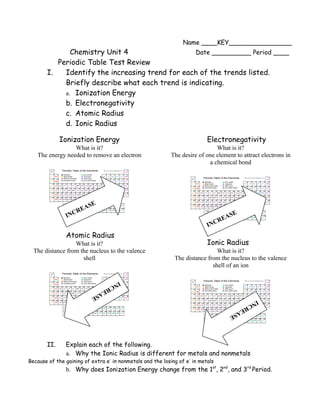
Periodic Table Test Review
- 1. Name ____KEY________________ Chemistry Unit 4 Date __________ Period ____ Periodic Table Test Review I. Identify the increasing trend for each of the trends listed. Briefly describe what each trend is indicating. a. Ionization Energy b. Electronegativity c. Atomic Radius d. Ionic Radius Ionization Energy Electronegativity What is it? What is it? The energy needed to remove an electron The desire of one element to attract electrons in a chemical bond E AS RE I NC AS E RE INC Atomic Radius What is it? Ionic Radius The distance from the nucleus to the valence What is it? shell The distance from the nucleus to the valence shell of an ion IN RE C SE A IN RE C SE A II. Explain each of the following. a. Why the Ionic Radius is different for metals and nonmetals Because of the gaining of extra e- in nonmetals and the losing of e- in metals b. Why does Ionization Energy change from the 1st, 2nd, and 3rd Period.
- 2. Due to the increasing number of orbits that shield the attraction from the Nucleus. c. What causes electronegativity. Atoms that want to gain stability through a full valence shell. To do this they attempt to attract neighboring electrons found in chemical bonds. III. Solve the following using a periodic table when needed. # Group Group Name # enegy Period Electron Configuration valence # levels # e- 1 1 Alkali 1 1 1s 1 2 2 Alkali Earth 2 2 1s 2s 2 2 8 18 Noble Gas 3 3 1s 2s 2p 3s 3p 2 2 6 2 6 1 1 Alkali 4 4 1s 2s 2p 3s 3p 4s 2 2 6 2 6 1 7 17 Halogens 4 4 1s 2s 2p 3s 3p 4s 3d 4p 2 2 6 2 6 2 10 5 IV. Use a periodic table to answer the following questions. Write the correct symbol from the periodic table. Fr 1. The largest radius Alkali metal Uuh 8. Highest atomic mass F 2. Period 2 Halogen He 9. Period 1 Noble gas Ca 3. Two electrons in 4th level Be 10. Least active Alkaline Earth metal Th 4. An actinide series element P 11. Largest radius nonmetal period 3 P 5. Period 3, Nitrogen group Y 12. Transition metal in period 5 Si_____ 6.Metalloid in group 13 Cu_____ 13.Smallest radius atoms group 11 _F____ 7.Highest Ionization Energy _Fr____ 14.Lowest Electronegativity V. Identify the following as a metal, nonmetal or metalloid. Metal 1. Sodium Metalloid 4. Silicon
- 3. nonmetal 2. Neon Nonmetal 5. Nitrogen nonmetal 3. Hydrogen Metal 6. Calcium VI. Fill in the blanks using vocabulary terms from unit three. Periods 1. Horizontal rows on the periodic table are called __. Groups 2. Vertical columns on the periodic table are called __. Families 3. Groups are often called __ because the elements behave similarly to each other. Metalloid 4. If an element has properties of both metals and nonmetals it is known as a __. Ionization Energy 5. The amount of energy required to remove an electron from the valence shell of an atom is known as __. Electronegativity 6. The tendency for an atom to attract electrons to itself when bonding with another element. Ion 7. When an atom gains or loses electrons it becomes this. Anion 8. If an atom gains electrons it becomes a(n) __. Cation 9. If an atom loses electrons it becomes a(n) __. Valence Electrons 10. Electrons in the outermost energy level are known as __ electrons. Octet Rule 11. Atoms react by gaining or losing electrons so as to acquire the stable electron structure of a noble gas. (Usually 8 valence electrons) This is called the __. Atomic Number 12. The number of protons in the nucleus of an atom is known as the __. Atomic Mass 13. The number of protons and neutrons in the nucleus of an atom is known as the __. D. Mendleev_______ 14. He published the first periodic table. VII. Trends of the Periodic Table – Write increase or decrease on each line. Periodic Table Trend As you go down the table… As you go across the table… (left
- 4. to right) Atomic Number and Mass I I Atomic Radius I D Ionization Energy D I Metallic Character I D Electronegativity D I VIII. Short Answer – Answer the following in complete sentences. 1. State the Periodic Law. law stating that many of the physical and chemical properties of the elements tend to recur in a systematic manner with increasing atomic number. 2. Explain why the atomic radius increases as you go down the periodic table. Atomic Radius increases as you go down the periodic table due to the increasing number of orbits. If the valence shell possess few electrons you will have a larger radius because the shielding effect of the inner orbits on the nucleus. The shielding does not allow the nucleus to attract the valence electrons causing a larger radius. 3. Explain why ionization energy decreases as you go down the periodic table. Ionization energy decreases as you move down the periodic table due to the shielding of valence electrons by inner shells. Also, the fewer valence electrons an atom has the less it wants to hold on to them. An atom would choose to lose valence electrons in order to gain stability. 4. Why are the noble gases so unreactive? Full valence shell IX. Activity Series. Write out the activity series with the catalysts for each. NOT APPEARING ON THIS TEST. • Describe reactivity for each metal in forming a solution. – zinc + lead nitrate solution – iron + zinc sulphate solution – lead + copper nitrate solution – magnesium + zinc chloride solution